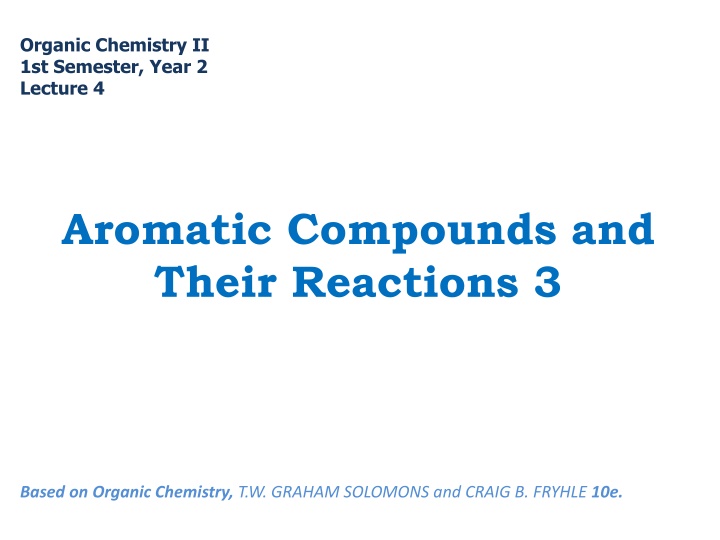
Aromatic Compounds and Their Reactions in Organic Chemistry II
Explore the reactions of alkylbenzene side chains, benzylic radicals and cations, halogenation, alkenylbenzenes, oxidation processes, and synthetic applications in organic chemistry illustrated by T.W. Graham Solomons and Craig B. Fryhle. Learn about arenes, benzylic and allylic radicals, stability of conjugated alkenylbenzenes, and more.
Download Presentation

Please find below an Image/Link to download the presentation.
The content on the website is provided AS IS for your information and personal use only. It may not be sold, licensed, or shared on other websites without obtaining consent from the author. If you encounter any issues during the download, it is possible that the publisher has removed the file from their server.
You are allowed to download the files provided on this website for personal or commercial use, subject to the condition that they are used lawfully. All files are the property of their respective owners.
The content on the website is provided AS IS for your information and personal use only. It may not be sold, licensed, or shared on other websites without obtaining consent from the author.
E N D
Presentation Transcript
Organic Chemistry II 1st Semester, Year 2 Lecture 4 Aromatic Compounds and Their Reactions 3 Based on Organic Chemistry, T.W. GRAHAM SOLOMONS and CRAIG B. FRYHLE 10e.
Reactions of the Side Chain of Alkylbenzenes Hydrocarbons that consist of both aliphatic and aromatic groups are also known as arenes. Phenylethene, usually called styrene, is an example of an alkenylbenzene. The aliphatic portion of these compounds is commonly called the side chain.
Benzylic Radicals and Cations: Hydrogen abstraction from the methyl group of methylbenzene (toluene) produces a radical called the benzyl radical: Departure of a leaving group (LG) from a benzylic position produces a benzylic cation:
Halogenation of the Side Chain: Benzylic Radicals Benzylic halogenation is carried out in the absence of Lewis acids and under conditions that favour the formation of radicals. Side-chain chlorination Benzylic and allylic radicals are even more stable than tertiary radicals.
Alkenylbenzenes Stability of Conjugated Alkenylbenzenes Additions to the Double Bond of Alkenylbenzenes
Oxidation of the Side Chain Alkylbenzenes with alkyl groups longer than methyl are ultimately degraded to benzoic acids: Side-chain oxidation is not restricted to alkyl groups. Alkenyl, alkynyl, and acyl groups are also oxidized by hot alkaline potassium permanganate.
Oxidation of the Benzene Ring The benzene ring carbon where an alkyl group is bonded can be converted to a carboxyl group by ozonolysis, followed by treatment with hydrogen peroxide.
Synthetic Applications Part of the skill in planning a synthesis is deciding in what order to carry out the reactions. Example, we want to synthesize o-bromonitrobenzene Other examples in which choosing the proper order for the reactions is important are the syntheses of the ortho-, meta-, and para-nitrobenzoic acids
We can synthesize m-nitrobenzoic acid by reversing the order of the reactions
Use of Protecting and Blocking Groups Very powerful activating groups such as amino groups and hydroxyl groups cause the benzene ring to be so reactive that undesirable reactions may take place.
Suppose, however, that we need o-nitroaniline. The synthesis that we just outlined would obviously not be a satisfactory method, for only a trace of o-nitroacetanilide is obtained in the nitration reaction.
Orientation in Disubstituted Benzenes When two different groups are present on a benzene ring, the more powerful activating group generally determines the outcome of the reaction. An ortho para director takes precedence over a meta director in determining the position of substitution because all ortho para-directing groups are more activating than meta directors. Steric effects are also important in aromatic substitutions. Substitution does not occur to an appreciable extent between meta substituents if another position is open.
Allylic and Benzylic Halides in Nucleophilic Substitution Reactions
Reduction of Aromatic Compounds The Birch Reduction






















